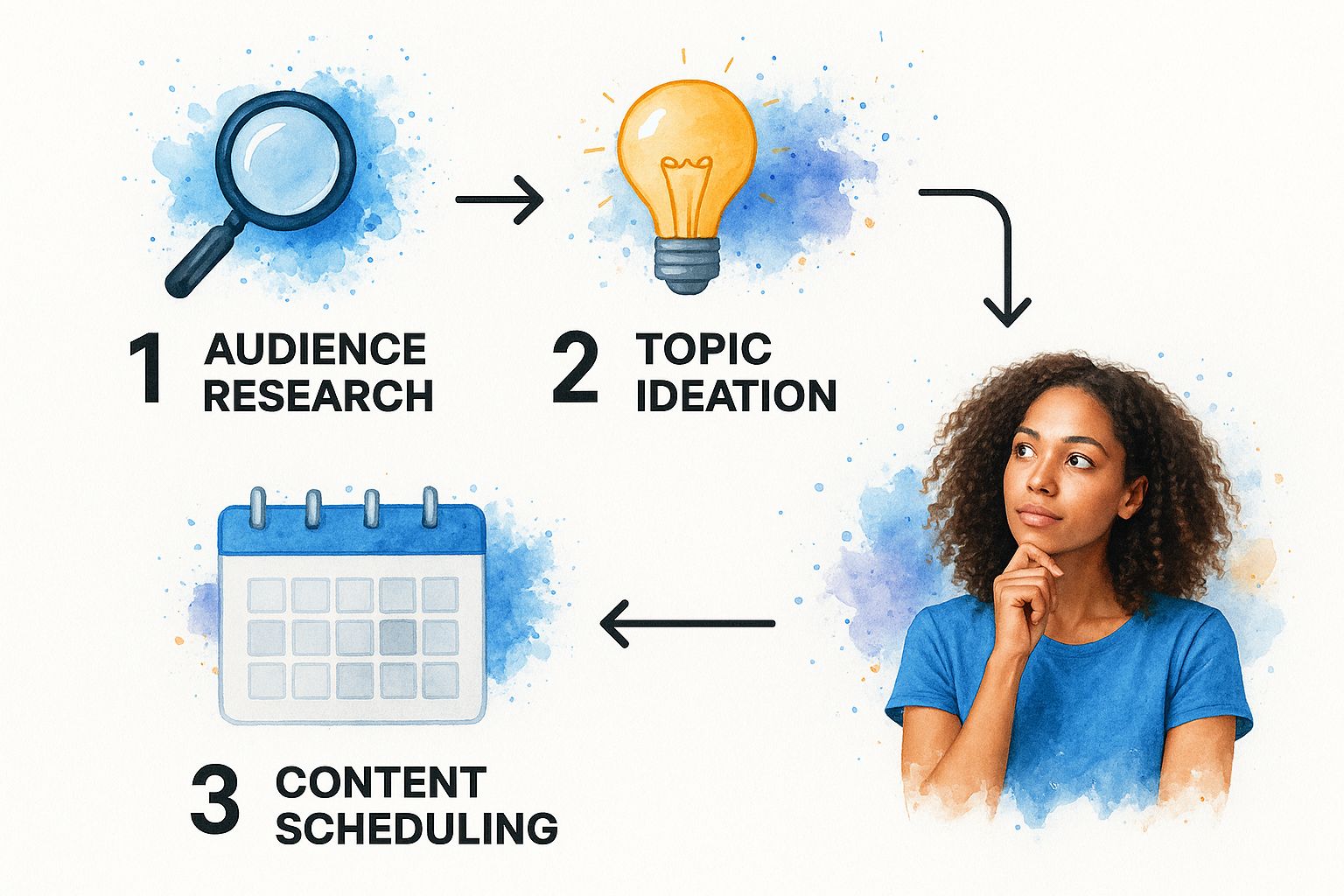Your Essential Content Marketing Strategy Guide

A good content marketing strategy is your roadmap. It's the master plan for creating and sharing content that pulls in the right audience, keeps them hooked, and ultimately turns them into loyal customers. It’s what separates random acts of marketing from a deliberate system built for growth.
What Is a Content Marketing Strategy Anyway?
Think about building a house. You wouldn't just show up with a pile of lumber and start nailing boards together, would you? Of course not. You'd start with a blueprint—a detailed plan showing the foundation, the structure, where the rooms go, and how the wiring connects everything. That blueprint ensures you end up with a stable, functional home instead of a chaotic mess.
A content marketing strategy is that exact blueprint for your marketing.
It's the high-level vision that answers the all-important "why" behind every piece of content you create. It's not about the individual tasks, like writing one blog post or filming one video. It’s the overarching game plan that defines what topics you’ll own, who you're talking to, where you’ll publish, and how it all ties back to what your business is trying to achieve.

Strategy Versus Tactics
It’s really easy to mix up strategy and tactics, but the difference is night and day. Tactics are the specific actions you take. The strategy is the reason you're taking them.
- Tactic: Publishing a blog post every Tuesday.
- Strategy: Becoming the go-to authority on specific topics to build trust and generate a steady stream of organic leads through search.
- Tactic: Posting a short-form video on social media.
- Strategy: Grabbing the attention of a younger audience and boosting brand awareness on the platforms where they spend their time.
Without a strategy, your tactics are just disconnected efforts. You could be creating fantastic content, but if it doesn't serve a bigger purpose, its impact will be minimal. It’s like having a top-notch construction crew with no blueprint—they'll work hard, but they’ll end up building something that makes no sense.
A content marketing strategy transforms your efforts from just "making stuff" into a predictable engine for business growth. It provides direction, purpose, and a clear path to measure your return on investment.
Why You Need a Blueprint
Having a documented strategy is the difference between hoping for results and actually engineering them. It gets your entire team—from writers to social media managers—on the same page, pushing toward the same goals. This kind of alignment is huge; studies consistently show that organizations with a documented strategy blow past those who don't have one.
Beyond that, a solid plan forces you to get crystal clear on your audience, nail down your unique brand voice, and connect your content directly to the customer journey. If you're looking to dive deeper into a specific channel, this ultimate social media content strategy guide is a great resource.
Ultimately, it all comes down to building a foundation that can support real, long-term success.
The Pillars of a Powerful Content Strategy
Any great structure needs a rock-solid foundation. The same goes for your content marketing. A high-impact strategy isn’t just one big idea; it's a mix of interlocking pillars that hold the whole thing up. Get these right, and you’ll build a marketing engine that turns random acts of content into predictable, measurable results.
If you skip this foundational work, you’re just creating content in the dark. It won’t connect with anyone, your brand will feel inconsistent, and you’ll have no way to prove it’s actually working. With the global content marketing market valued at 413.2 billion** in 2022 and projected to hit an incredible **2 trillion by 2032, a structured approach is no longer optional. You can dig into more of this explosive growth with these content marketing trends and statistics.

Developing Deep Audience Personas
Before you even think about writing a headline, you need to know exactly who you’re talking to. That’s where audience personas come in. Think of a persona not as a vague demographic, but as a detailed profile of your ideal customer—a semi-fictional character with real goals, frustrations, and motivations.
Creating content without a clear persona is like telling a joke in an empty room. You might think it's funny, but who are you trying to make laugh? A well-defined persona is the compass that guides every single content decision you make.
To bring your persona to life, start by answering a few key questions:
- What’s their job and industry? (e.g., "Melanie, a founder of a boutique marketing agency.")
- What keeps them up at night? What are their biggest pain points? (e.g., "She’s struggling to generate a steady stream of qualified leads.")
- Where do they hang out online to get information? (e.g., Specific industry blogs, certain LinkedIn groups, or particular YouTube channels.)
- What makes them finally pull the trigger on a purchase? (e.g., "She needs a solution that saves her team time and proves a clear ROI to her clients.")
This level of clarity ensures your content feels like a one-on-one conversation, addressing the very problems your ideal customer is trying to solve.
Defining Your Brand Voice and Positioning
Once you know your audience, you have to figure out how you’re going to sound when you talk to them. Your brand voice is the unique personality that comes through in all your communications. Are you witty and informal? Or are you more authoritative and buttoned-up?
Then there's your positioning. In a sea of competitors, you can't be everything to everyone. You have to carve out a specific, memorable space in your audience's mind. What makes you different?
Your brand voice isn't just about the words you choose, but how you say them. It’s the consistent thread that builds familiarity and trust, whether someone is reading a blog post, a tweet, or an email.
Think about the difference between Mailchimp's friendly, encouraging tone and IBM's expert, formal one. Both work perfectly because they’re consistent and match what their audience expects. A clear voice makes you instantly recognizable.
Aligning Content with Business Goals
Content for the sake of content is a waste of time and money. Every article, video, or podcast episode needs a job to do. This is the pillar that ties your creative efforts directly to tangible business outcomes.
Start by asking, "What are we actually trying to achieve here?" Are you trying to boost brand awareness? Generate more leads? Or maybe improve customer retention? Each goal demands a different content approach and will be measured by different Key Performance Indicators (KPIs).
Here’s how this alignment looks in the real world:
- Business Goal: Increase qualified leads by 20% this quarter.
- Content Strategy: Create content for people ready to buy, like in-depth case studies, product comparison guides, and webinar sign-ups.
- KPIs to Track: Landing page conversion rates, number of Marketing Qualified Leads (MQLs), and the overall cost per lead.
Making this connection is how you prove the value of your content marketing strategy and get the budget for even bigger things next year.
Building Content Pillars and Topic Clusters
Finally, to truly establish yourself as an authority and win in the search rankings, you need to structure your content intelligently. This is where content pillars and topic clusters are a game-changer. Think of a content pillar as a huge, comprehensive guide on a broad topic.
From that central pillar, you create a series of smaller, more focused "cluster" articles that dive deep into related subtopics. Each of these cluster posts links back to the main pillar page, creating a powerful, interconnected web of content.
This model does two crucial things. First, it signals to search engines like Google that you’re an expert on a subject, which boosts your authority and helps you rank for those big, competitive keywords. Second, it creates a logical journey for your audience, seamlessly guiding them from a broad interest to the specific answers they need.
Building Your Content Strategy From Scratch
Alright, with the fundamentals covered, it's time to roll up our sleeves and start building. This is where the theory gets real, and we turn that high-level blueprint into an actual, working plan.
Crafting a content strategy from the ground up can feel like a huge undertaking, but it’s really just a series of logical steps. Think of it like building with LEGOs—you wouldn't just empty the box and hope a masterpiece emerges. You follow the instructions, piece by piece, until you have something solid and functional.
These next steps are your instruction manual. We're getting hands-on, moving from the "why" to the "how." By the time we're done, you'll have a documented, tangible plan you can actually execute, not just a vague collection of ideas.
Set a Clear Content Mission
Before a single word gets written, you need a North Star. Your content mission statement is a short, sharp sentence or two that nails down who you're creating for, what you're creating, and the value you're promising to deliver. This isn't some fluffy marketing tagline for your website; it's an internal compass that keeps every single piece of content pointing in the same direction.
A killer mission statement has three core parts:
- Your Core Audience: Who are you really trying to help? (e.g., "early-stage SaaS founders")
- What You'll Deliver: What are you giving them? (e.g., "actionable, data-backed marketing guides")
- The Desired Outcome: What change will you create for them? (e.g., "to scale their lead generation efforts sustainably")
Put it all together, and you get something like this: "To provide early-stage SaaS founders with actionable, data-backed marketing guides that help them scale their lead generation efforts sustainably." Instantly, anyone on your team knows exactly what your content engine is built to do.
Define Your Business Goals and KPIs
Your mission gives you direction, but your business goals make sure you're actually getting somewhere. Every article, video, or social post needs a job to do—a job that directly supports a bigger company objective. Fuzzy goals like "get more traffic" just won't cut it.
This is the moment you tie your content directly to revenue and growth. Use the SMART goal framework (Specific, Measurable, Achievable, Relevant, Time-bound) to stop guessing and start measuring.
A classic mistake is getting obsessed with top-of-funnel vanity metrics like page views. A truly effective content strategy tracks the entire journey, from that first click all the way to a sale and beyond.
For example, a weak goal is "Improve our SEO." A SMART goal sounds more like: "Increase organic blog traffic by 25% and generate 150 new MQLs from our content in Q3 by targeting bottom-of-funnel keywords." See the difference? Now you can track your progress and actually prove your content's ROI.
Conduct a Content and SEO Audit
You can't map out a route to your destination if you don't know where you're starting from. A content audit is a deep dive into everything you've already published, while an SEO audit checks the technical health and search visibility of your site. This process uncovers what’s working, what's a dud, and where the low-hanging fruit is.
Key areas to dig into during your audit:
- Top Performers: Pinpoint the articles and pages bringing in the most traffic, leads, and conversions. These are your golden templates—figure out why they work and do more of it.
- Underperforming Assets: Find the content that's just collecting dust. You'll need to decide whether to update it, merge it with something better, or just hit delete.
- Content Gaps: What are people asking that you aren't answering? Keyword research tools are great for finding topics your competitors are ranking for that you've completely missed.
- Technical SEO Gremlins: Look for issues like slow page speeds, broken links, or a clunky mobile experience. These problems can torpedo your rankings, no matter how good your content is.
This audit gives you a solid baseline and stops you from reinventing the wheel. And when you're ready to brainstorm new topics, you can explore a ton of creative prompts for marketing to get the ideas flowing.
The whole process naturally flows from understanding your audience to brainstorming ideas and, finally, to getting things on the calendar.

This simple flow is a powerful reminder that great content isn't random. It starts with deep customer understanding and moves methodically toward execution, ensuring everything you create has a clear purpose.
Map the Customer Journey
Last but not least, you need to organize your content ideas around how your customers actually buy. People don't just show up on your site ready to purchase; they go through distinct stages. Your job is to create content that meets them at each step.
- Awareness Stage: The person has a problem, but they might not have the words for it yet. They're just starting to feel the pain. Your content here should be purely educational and problem-focused—think "how-to" guides, checklists, and beginner-friendly blog posts.
- Consideration Stage: Now, they've defined their problem and are actively researching solutions. This is where you can go deeper and show off your expertise with content like detailed case studies, product comparison guides, and expert webinars.
- Decision Stage: They're ready to pull the trigger and are just trying to decide who to go with. Your content needs to build trust and make it easy for them to choose you. This is the place for free trials, live demos, customer testimonials, and clear pricing pages.
By mapping your content to these stages, you create a system that naturally guides people from their first-ever Google search right through to becoming a happy customer. It transforms your content from a collection of one-off articles into a strategic engine for growth.
Content Strategy Development Checklist
To help you stay organized, here’s a simple checklist to walk you through the process. Think of it as your project plan for building a killer content strategy from the ground up.
| Step Number | Action Item | Key Deliverable | Status (To Do / In Progress / Complete) |
|---|---|---|---|
| 1 | Define Your Content Mission | A clear, 1-2 sentence mission statement. | |
| 2 | Set Business Goals & KPIs | 3-5 SMART goals with specific metrics. | |
| 3 | Identify Your Target Audience | Detailed buyer personas for each segment. | |
| 4 | Conduct Content & SEO Audit | A report on top/low performers and content gaps. | |
| 5 | Research Competitors | Analysis of competitors' content strengths/weaknesses. | |
| 6 | Brainstorm Core Content Topics | A list of topic clusters aligned with your mission. | |
| 7 | Map Content to the Customer Journey | A matrix of content ideas for each funnel stage. | |
| 8 | Choose Your Content Formats | A list of primary formats (blog, video, etc.). | |
| 9 | Select Distribution Channels | A list of channels to promote your content. | |
| 10 | Create a Content Calendar | A documented schedule for content production. |
This checklist ensures you don't miss any critical steps. Work through it methodically, and you'll end up with a comprehensive strategy that's ready for action.
Designing Your Content Creation Engine

A brilliant content marketing strategy guide on paper is one thing. Actually bringing it to life, week after week, is what separates the pros from the amateurs. Without a solid system for producing content, even the best plans crash and burn from burnout, missed deadlines, and sloppy work. The solution? Build a content creation engine.
Think of it like an assembly line. Raw materials—your ideas—go in one end. They move through a series of structured stages like writing, editing, and design, and come out the other side as a polished final product. This engine is what turns chaotic, last-minute scrambling into a smooth, repeatable workflow.
Building Your Content Calendar
The content calendar is the command center for your entire engine. It’s so much more than a simple list of publish dates; it's the single source of truth for your whole team. A well-kept calendar guarantees a steady flow of valuable content and kills those panicked "what are we posting today?!" moments for good.
For every single piece of content, your calendar should track the essentials:
- Topic and Title: The core idea and a working headline.
- Content Format: Is it a blog post, a video, an infographic, or something else?
- Target Persona: Which of your audience segments is this for?
- Funnel Stage: Is this for Awareness, Consideration, or Decision?
- Status: Where is it on the assembly line? (e.g., Writing, In Review, Scheduled).
- Publish Date: The day it’s scheduled to go live.
This level of organization gives everyone on the team a clear view of the pipeline, making it a breeze to plan ahead and keep the engine humming.
Ideation and Topic Brainstorming
Your content engine needs a constant supply of high-quality fuel, and that fuel is great ideas. Brainstorming can't be a random, once-in-a-while activity. It needs its own system to ensure you're consistently generating topics that actually connect with your audience and support your business goals.
Start by going back to your audience personas and customer journey map. What are their biggest questions at each stage? What problems keep them up at night? Use keyword research tools to see what people are actively searching for, and lurk on social media and online forums to listen in on real conversations. Don't forget your own sales and support teams—they're sitting on a goldmine of ideas pulled directly from customer pain points.
The best content ideas live at the intersection of what your audience is asking for and what your brand has the authority to answer. Don't just create what you want to talk about; create what they need to hear.
Establishing a Production Workflow
Once an idea makes it onto the calendar, it needs to move down your production line. A documented workflow clarifies who does what, sets clear expectations, and guarantees a quality check at every step. This process is absolutely vital if you want to scale up your output without letting quality slide.
A typical content workflow might look something like this:
- Briefing: The content strategist creates a detailed brief outlining the topic, target keyword, audience, and key talking points.
- Writing: The writer takes the brief and drafts the content. For those looking to sharpen their skills, our guide on copywriting prompts can provide excellent inspiration.
- Editing: An editor reviews the draft for clarity, tone, grammar, and alignment with the brief.
- Design: A designer creates any needed visuals, like custom graphics, charts, or images.
- Final Review: The strategist or another stakeholder gives the final thumbs-up.
- Scheduling: The piece is loaded into your CMS and scheduled for publication.
This step-by-step process gets rid of any guesswork. Everyone knows who is responsible for what, which prevents bottlenecks and keeps your engine running smoothly.
Choosing the Right Content Formats
While blog posts are the cornerstone of many strategies, any modern content marketing strategy guide has to acknowledge the massive shift toward visual content. The data doesn't lie: one recent study found that by 2025, a staggering 83% of consumers want to see more video content from brands.
This tells us we have to diversify our content formats to meet people where they are and maximize engagement. By designing a repeatable engine for creation—from the calendar that organizes it all to the workflow that gets it done—you build a sustainable system. This is how you deliver a steady stream of high-quality content that keeps your audience hooked and your brand top-of-mind.
Distributing Content Where It Will Be Seen
Look, creating a brilliant piece of content is a huge win, but that's only half the battle. If your masterpiece just sits on your blog gathering digital dust, it's not going to drive traffic, pull in leads, or build your brand. The next make-or-break step is distribution—the actual work of getting your content in front of the right eyeballs.
Think of it like this: you’ve just baked the most incredible cake. Distribution is the part where you slice it up and hand-deliver it to people you know will love it, instead of just leaving it on your kitchen counter and hoping someone wanders in. Smart distribution is what turns your hard work into real results.
Owned, Earned, and Paid Channels
A rock-solid distribution plan never puts all its eggs in one basket. Instead, it leverages a powerful mix of three different types of media to cast a wider net and connect with your audience wherever they hang out.
- Owned Channels: These are the platforms you have complete control over. We're talking about your company blog, your email newsletter, and your main social media profiles. They are the home base for all your distribution efforts.
- Earned Channels: This is the digital word-of-mouth you don't pay for. It’s the organic buzz that comes from social media shares, shout-outs from industry influencers, press coverage, or even guest posts you write for other blogs.
- Paid Channels: This is where you pay to play. Think social media ads (like on Facebook or LinkedIn), pay-per-click (PPC) campaigns on Google, and sponsored content placements.
The real magic happens when you blend all three. You might publish an in-depth guide on your blog (owned), boost its visibility with targeted social media ads (paid), and then get industry experts to share it with their followers (earned).
The Power of Content Repurposing
One of the smartest moves you can make is to stop thinking of each piece of content as a one-and-done deal. Content repurposing is all about taking one core asset and spinning it into multiple formats for different channels. This approach saves a ton of time and lets you reach different audience segments with content that’s perfectly suited for how they like to consume it.
For instance, a single, in-depth blog post can be broken down and rebuilt into a whole new content arsenal:
- A visually slick infographic that boils down the key stats.
- A short, punchy video for YouTube or LinkedIn.
- A series of quote graphics and takeaways for Twitter and Instagram.
- A detailed slide deck for SlideShare.
- A full script for a podcast episode.
By repurposing one comprehensive article into five or more smaller assets, you extend its lifespan and multiply its reach across platforms that favor different formats. It’s all about working smarter, not harder.
Advanced Distribution Tactics
Once you’ve hit publish, getting your content seen is everything. A great next step is to implement a robust content syndication strategy, which involves getting your work published on third-party sites. This can expose your brand to completely new audiences you wouldn't otherwise reach.
On top of that, focus on building genuine relationships with influencers and creators in your niche. A friendly collaboration can open up massive promotional opportunities.
And don’t forget, search engine optimization is a form of distribution in itself. By properly optimizing your content, you’re actively distributing it to people who are searching for answers on Google right now. For a deeper dive, check out our collection of high-quality SEO prompts designed to help you craft perfectly optimized content from the get-go.
How to Measure and Improve Your Strategy
Creating content without measuring its impact is like flying blind. You’re putting in a ton of effort, but you have no real idea if you’re heading in the right direction. To stop guessing and start knowing, you need to track the right data and turn your strategy into a living document that gets better over time.
This isn’t about pulling a one-time report. It’s a constant loop of measuring, learning, and tweaking. By zeroing in on the right metrics, you can confidently prove your content's value and make data-driven decisions that actually fuel business growth.
Identifying Your Key Performance Indicators
First things first, you need to choose your Key Performance Indicators (KPIs). These are the specific, measurable numbers that tell you how well you’re hitting your business goals. Your KPIs will shift depending on what you want a piece of content to achieve and where it fits in the customer journey.
- Top-of-Funnel (Awareness): At this stage, it’s all about reach. How many new people are discovering you? Keep an eye on organic traffic, social media shares, backlinks, and brand mentions. These numbers tell you if you’re successfully grabbing new eyeballs.
- Middle-of-Funnel (Consideration): Now, the focus shifts from reach to engagement. Are people sticking around? Track metrics like time on page, bounce rate, and email newsletter sign-ups. A high time on page is a fantastic signal that your content is genuinely valuable and holding their attention.
- Bottom-of-Funnel (Decision): This is where content turns into conversions. The most crucial KPIs here are lead generation (think demo requests or trial sign-ups), conversion rate, and the big one—Return on Investment (ROI). These metrics directly connect your content efforts to the bottom line.
A classic mistake is getting hung up on vanity metrics like page views. A truly solid strategy tracks the entire funnel, from the very first click to the final sale, making sure every piece of content has a measurable job to do.
The Measure, Learn, Optimize Loop
Once you've got your KPIs locked in, it’s time to put a continuous improvement cycle into action. This simple framework ensures your strategy doesn't just sit there—it evolves and gets smarter.
- Measure: Use tools like Google Analytics to consistently track your chosen KPIs. Set up a dashboard to keep an eye on performance, which helps you spot trends and identify outliers without having to dig for them.
- Learn: The data tells a story. It's your job to read it. Which blog posts are bringing in the most leads? What content formats get shared the most? This is where you connect the dots between the numbers and your specific articles, videos, or campaigns.
- Optimize: Now that you have some real insights, it’s time to act. Double down on what's working—create more content on similar topics or in formats that are clear winners. For the stuff that’s falling flat, you have a few options: update it with fresh info, merge it with a better-performing piece, or just get rid of it.
This cycle turns your content strategy from a static plan into a dynamic system that sharpens with every iteration. Technology plays a huge role here; in fact, over 80% of marketers now use AI to help personalize content and optimize performance on the fly. You can dive deeper into how AI is shaping content marketing and find more useful statistics on typeface.ai.
Frequently Asked Questions
Even the most thorough guide can leave a few questions lingering. It's totally normal. Let's tackle some of the most common ones that come up when you're getting your content marketing engine running.
How Long Until I See Results?
This is the big one, isn't it? The honest answer is: content marketing is a long game. It’s a marathon, not a sprint.
While you can always get a quick traffic spike from paid ads, building real, sustainable authority with your audience takes time. Generally, you can expect to see meaningful results—like a real uptick in organic traffic and leads trickling in—within 6 to 12 months of consistent, high-quality work.
How Much Should I Budget for Content?
There’s no magic number here, as your budget really comes down to your goals, your industry, and how big your operation is.
A small business might start out smart by investing in a handful of excellent blog posts from a skilled freelancer. On the other end of the spectrum, large companies will pour significant resources into dedicated teams, video production, and sophisticated analytics tools. If you're just starting, the best advice is to focus on quality over sheer volume. One amazing article is worth more than ten mediocre ones.
Ready to supercharge your content creation with AI? Find top-tier prompts for any project on PromptDen. Visit us at https://promptden.com to explore our marketplace and discover your next great idea.